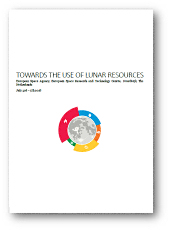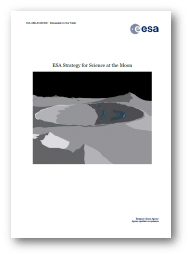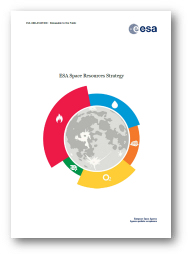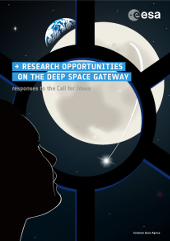ESA - Exploration of the Moon - Publications Archive
Publication archive
Publication archive
A new era of space exploration is beginning, with multiple international and private sector actors engaged and with the Moon as its cornerstone. This renaissance in lunar exploration will offer new opportunities for science across a multitude of disciplines from planetary geology to astronomy and astrobiology whilst preparing the knowledge humanity will need to explore further into the Solar System. Recent missions and new analyses of samples retrieved during Apollo have transformed our understanding of the Moon and the science that can be performed there. We now understand the scientific importance of further exploration of the Moon to understand the origins and evolution of Earth and the cosmic context of life's emergence on Earth and our future in space.
ESA's priorities for scientific activities at the Moon in the next ten years are:
- Analysis of new and diverse samples from the Moon.
- Detection and characterisation of polar water ice and other lunar volatiles.
- Deployment of geophysical instruments and the build up a global geophysical network.
- Identification and characterisation of potential resources for future exploration.
- Deployment long wavelength radio astronomy receivers on the lunar far side.
- Characterisation of the dynamic dust, charge and plasma environment.
- Characterisation of biological sensitivity to the lunar environment.
The resources of space offer a means to enable sustainable exploration of the Moon and Solar System beyond in support of the advancement of ESA's space exploration strategy. The challenge of space resources can also be a means to stimulate innovation on Earth, to find new ways to address global challenges and to generate near to mid-term economic returns for terrestrial industries.
The utilisation of space resources for exploration may be within reach for the first time; made possible by recent advances in our knowledge and understanding of the Moon and asteroids, increased international and private sector engagement in space activities and the emergence of new technologies. Key sectors of interest include mining, metallurgy, materials, energy, robotics and autonomy. The first utilisation of space resources will be on the Moon; a source of water, oxygen, metals and other materials.
The strategy covers the period up to 2030, by which time the potential of lunar resources will have been established through measurements at the Moon, key technologies will have been developed and demonstrated and a plan for their introduction into international mission architectures will have been defined. Priorities for investments will be based on the available materials at the Moon, their applications in exploration and the demonstrated interest from terrestrial industries to partner and co-invest.
The resources of Mars and asteroids are also important considerations and activities at the Moon should prepare the way for future utilisation at these locations.
 |
Between the 3rd and 5th of July 2018 more than 250 people came together at ESA's European Space Research and Technology Centre in the Netherlands, to explore the opportunities presented by the use of lunar resources. Participants were present from industry and academia, from space and terrestrial sectors and from agencies and public sector organisations. The three-day workshop included around 100 presentations and discussions. Areas discussed included rationales, science, technology, legal aspects and economics.
The major findings of the meeting are summarised in this document.
Content:
Summary
Architectures and Use Cases
Prospecting
Basic Fundamental and Applied Research
Technology
1) Polar volatiles
2) Oxygen and water production from regolith
3) Materials and construction technologies
4) Regolith handling and processing
5) Energy
What needs to be done on the Moon?
Analogues and simulants
Legality and governance
Economics
Role of ESA
What next?
Authors
Between August and October 2017 ESA held a call for research ideas from the European research community to inform the development of the Deep Space Gateway; a spaceship in lunar vicinity, which will host crewed missions and operate without crew in between. The Deep Space Gateway is planned to be built and operated during the 2020's as humanities next step beyond Low Earth Orbit and out into the Solar System.
The more than 100 inputs received on the scientific and other research which could be performed on this platform were discussed and consolidated at a workshop at ESA ESTEC, in the Netherlands, on 5th and 6th December, which was attended by more than 200 people.
The end product of this consultation is a compendium of ideas for utilisation and a collection of findings and recommendations, contained within this document, which highlight the major research opportunities and the technical aspects upon which realisation of these opportunities depends.
Document reference: ESA-HSO-K-RP-0284; 1.1
In August 2017 ESA opened a Call for Ideas inviting members of the science community in Europe to propose research ideas that could be performed on the Deep Space Gateway (DSG), a crewed spaceship in lunar vicinity.
This document (pdf, 19.3MB) contains the ideas received in response to that call and accepted following review by a Science Advisory Team representing the various science working groups that support ESA's activities. Ideas are broadly categorised for the purposes of this document as: life sciences, physical sciences and astronomy, Solar System and Earth sciences, and technology.
Presented at 48th Lunar and Planetary Science Conference, held 20-24 March 2017, at The Woodlands, Texas. LPI Contribution No. 1964, id.2514
The Package for Resource Observation and in-Situ Prospecting for Exploration, Commercial exploitation and Transportation (PROSPECT) is in development by ESA for application at the lunar surface as part of international lunar exploration missions in the coming decade, including the Russian Luna-27 mission planned for 2021. Establishing the utilization potential of resources found in-situ on the Moon may be key to enabling sus-tainable exploration in the future. The purpose of PROSPECT is to support the identification of potential resources, to assess the utilization potential of those resources at a given location and to provide infor-mation to help establish the broader distribution. PROSPECT will also perform investigations into re-source extraction methodologies that maybe applied at larger scales in the future and provide data with important implications for fundamental scientific investigations on the Moon.


